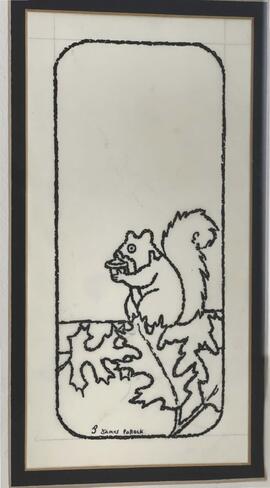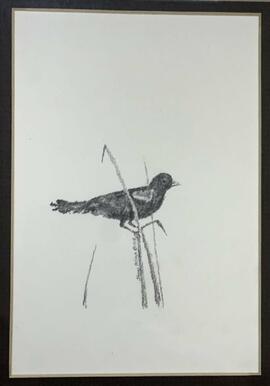Identity elements
Reference code
Name and location of repository
Level of description
Title
Date(s)
Extent
47.79 linear feet [7 record boxes, 7 oversize flat boxes, 9 frame enclosures]
Name of creator
Biographical history
James Pollock (born 1943, South Dakota) is an American artist based in Pierre, South Dakota, known for his work that blends abstract and concrete styles. His artistic range spans from the bold, geometric influences of the Bauhaus to interpretations reminiscent of ancient cave paintings and traditional landscape art. Pollock is an active member of the South Dakota Plein Air Artists movement.
Raised in Pollock, South Dakota, he was named after his great-grandfather and developed an early interest in art, which he pursued academically, earning a degree in art from South Dakota State University in 1965. After being drafted into the U.S. Army in 1966, Pollock served in the Vietnam Combat Artists Program, where his work became part of the U.S. Army Art Collection. His Vietnam War-era art has been widely exhibited, including at the Indianapolis Art Center and the National Constitution Center.
Following his military service, Pollock worked as a graphic artist and illustrator in South Dakota, contributing to various state publications and projects. His art has been featured in several notable exhibitions, both nationally and internationally. In 1980, he was named Artist of the Year by the South Dakota Cowboy and Western Heritage Hall of Fame. Pollock also designed the first issue gold and silver bullion pieces for the State of South Dakota in 1987 and has continued to create and exhibit art throughout his career. He is a founding member of Artists of the Black Hills, established in 2005.
In August 2018, Pollock was named the Harvey Dunn Award winner at a Plein Air painting competition in De Smet, South Dakota. Eighty-three artists from six states competed for the honor. Harvey Dunn, born on a homestead farm near De Smet, was a successful illustrator, teacher, and was selected by the American Expeditionary Forces as an official artist during WWI. The Harvey Dunn Society acknowledges his legacy through this annual award.[28]
In October 2018, Pollock, in collaboration with poet Steve Boint, published a book of art and poetry entitled Sketchbook 91-1-1.
Content and structure elements
Scope and content
The James Pollock Papers document the life, art, and contributions of South Dakota artist James Pollock, with a particular focus on his involvement in the U.S. Army's Combat Art Teams (CAT) and his artistic works related to the Vietnam War. The collection encompasses a wide range of materials, including notes, interviews, reports, articles, photographs, and sketches, offering a detailed look at Pollock’s creative process, his military experiences, and his artistic evolution both during and after his service. A central component of the collection highlights Pollock’s role in the Combat Art Teams, which aimed to capture the realities of war through visual art. His contributions span various phases of the Vietnam conflict and also includes material of other Combat Artist Team military assignments in locations such as Korea, Thailand, Germany, Alaska, and Panama.
The collection features numerous original ink sketches that showcase Pollock’s distinctive style and his evolving artistic vision over the years. These works cover a broad range of subjects, from wildlife and landscapes to human figures, frequently drawing inspiration from his South Dakota heritage. In addition to his war-related art, Pollock’s work has been exhibited in venues such as the Indianapolis Exhibit and the Robinson Museum in Pierre, South Dakota. Articles and press releases from publications like South Dakota Magazine and Vietnam Magazine document his artistic impact, highlighting the significance of his contributions to both military and civilian audiences.
Correspondence within the collection reveals Pollock's interactions with a diverse group of individuals, including political figures, fellow artists, military personnel, and veterans. These letters provide valuable insight into the professional and cultural networks that supported Pollock’s artistic endeavors.
Beyond his military and war-related art, the collection includes Pollock’s personal projects, such as his illustrations for Blood on the Killdeer by Dana Close Jennings, as well as his involvement in South Dakota’s Centennial and Bicentennial celebrations. His engagement with the public is further reflected in materials related to his participation in art forums for veterans. The collection also documents Pollock's media presence, including his web site, articles, and video content, which showcase his outreach efforts to veterans and the broader public.
Overall, the James Pollock Papers offer a comprehensive portrait of an artist whose work bridges military history, cultural heritage, and personal expression, underscoring the enduring impact of his artistic contributions.
System of arrangement
Conditions of access and use elements
Conditions governing access
Physical access
Good
Technical access
Conditions governing reproduction
Languages of the material
Scripts of the material
Language and script notes
Finding aids
Uploaded finding aid
Acquisition and appraisal elements
Custodial history
James Pollock donated this collection to SDSU Archives & Special Collection in 2024.
Immediate source of acquisition
Appraisal, destruction and scheduling information
The Archives can use the materials in any manner while giving credit to James Pollock. Art pieces may be loaned to public entities or museums that the Archives deems proper.
There are no restrictions regarding the use of the items.
Donor wishes that any of his art be available to others to create derivatives and manipulate regardless of medium, including digital and any future technology
If the Archives is no longer able to care for the material, they will be offered to the South Dakota State Historical Society, South Dakota Art Museum, Augustana Center for Western Studies, or returned to the Donor's family.
Accruals
Related materials elements
Existence and location of originals
Existence and location of copies
Related archival materials
Links to Pollock Interviews Online
- James Pollock Interview - 50 States (South Dakota), Creative Chair, June 2019
- Dakota Midday: Painter James Pollock And The Vietnam Combat Art Program, South Dakota Public Broadcasting, June 10, 2015
Related descriptions
Notes element
Specialized notes
Alternative identifier(s)
Description control element
Rules or conventions
Sources used
Access points
Subject access points
Place access points
Name access points
- Pollock, James (Subject)



